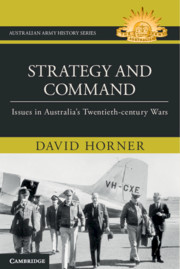Book contents
- Strategy and Command
- Other titles in the Australian Army History Series
- Acknowledgement of Country
- Strategy and Command
- Copyright page
- Contents
- Figures, maps and tables
- Preface
- Acknowledgements
- Abbreviations
- Introduction
- Chapter 1 The influence of the Boer War on Australia’s First World War commanders
- Chapter 2 Preparing for war, 1901–14
- Chapter 3 The AIF’s commanders
- Chapter 4 Strategic planning between the wars
- Chapter 5 Identifying the threat from Japan in 1941
- Chapter 6 A pivotal year in Australian history: 1942
- Chapter 7 Australia and coalition warfare in the Second World War
- Chapter 8 Deciding Australia’s war strategy in 1943
- Chapter 9 Advancing national interests
- Chapter 10 Higher command in the Korean War
- Chapter 11 Higher direction of the army in the Vietnam War
- Chapter 12 The Gulf War, 1991
- Chapter 13 Deploying and sustaining INTERFET in East Timor in 1999
- Chapter 14 Developing a command structure for joint operations
- Notes
- Bibliography
- Index
Chapter 7 - Australia and coalition warfare in the Second World War
Published online by Cambridge University Press: 08 October 2021
- Strategy and Command
- Other titles in the Australian Army History Series
- Acknowledgement of Country
- Strategy and Command
- Copyright page
- Contents
- Figures, maps and tables
- Preface
- Acknowledgements
- Abbreviations
- Introduction
- Chapter 1 The influence of the Boer War on Australia’s First World War commanders
- Chapter 2 Preparing for war, 1901–14
- Chapter 3 The AIF’s commanders
- Chapter 4 Strategic planning between the wars
- Chapter 5 Identifying the threat from Japan in 1941
- Chapter 6 A pivotal year in Australian history: 1942
- Chapter 7 Australia and coalition warfare in the Second World War
- Chapter 8 Deciding Australia’s war strategy in 1943
- Chapter 9 Advancing national interests
- Chapter 10 Higher command in the Korean War
- Chapter 11 Higher direction of the army in the Vietnam War
- Chapter 12 The Gulf War, 1991
- Chapter 13 Deploying and sustaining INTERFET in East Timor in 1999
- Chapter 14 Developing a command structure for joint operations
- Notes
- Bibliography
- Index
Summary
Australia entered the Second World War with considerable experience of coalition warfare, mainly based on the events of the First World War. Reflecting its recent history as a group of separate British colonies, by the First World War the new nation had not developed a foreign service and had little capacity for independent strategic decision-making. The Australian Government learned that its troops had landed at Gallipoli four days after the event; it had not even been advised, let alone consulted. By the last year of the war, however, the Australian Prime Minister was sitting in the Imperial War Cabinet, although this was not a permanent arrangement. Similarly, at the operational level, the formations of the Australian Imperial Force (AIF) became part of the wider Empire’s military forces and were deployed and employed by British commanders, who rarely consulted the senior Australian commanders. But by the last year of the war senior Australian commanders had learned to scrutinise the plans of their British superiors. Coalition warfare is therefore essentially about strategy and command.
Keywords
- Type
- Chapter
- Information
- Strategy and CommandIssues in Australia's Twentieth-century Wars, pp. 124 - 143Publisher: Cambridge University PressPrint publication year: 2021

